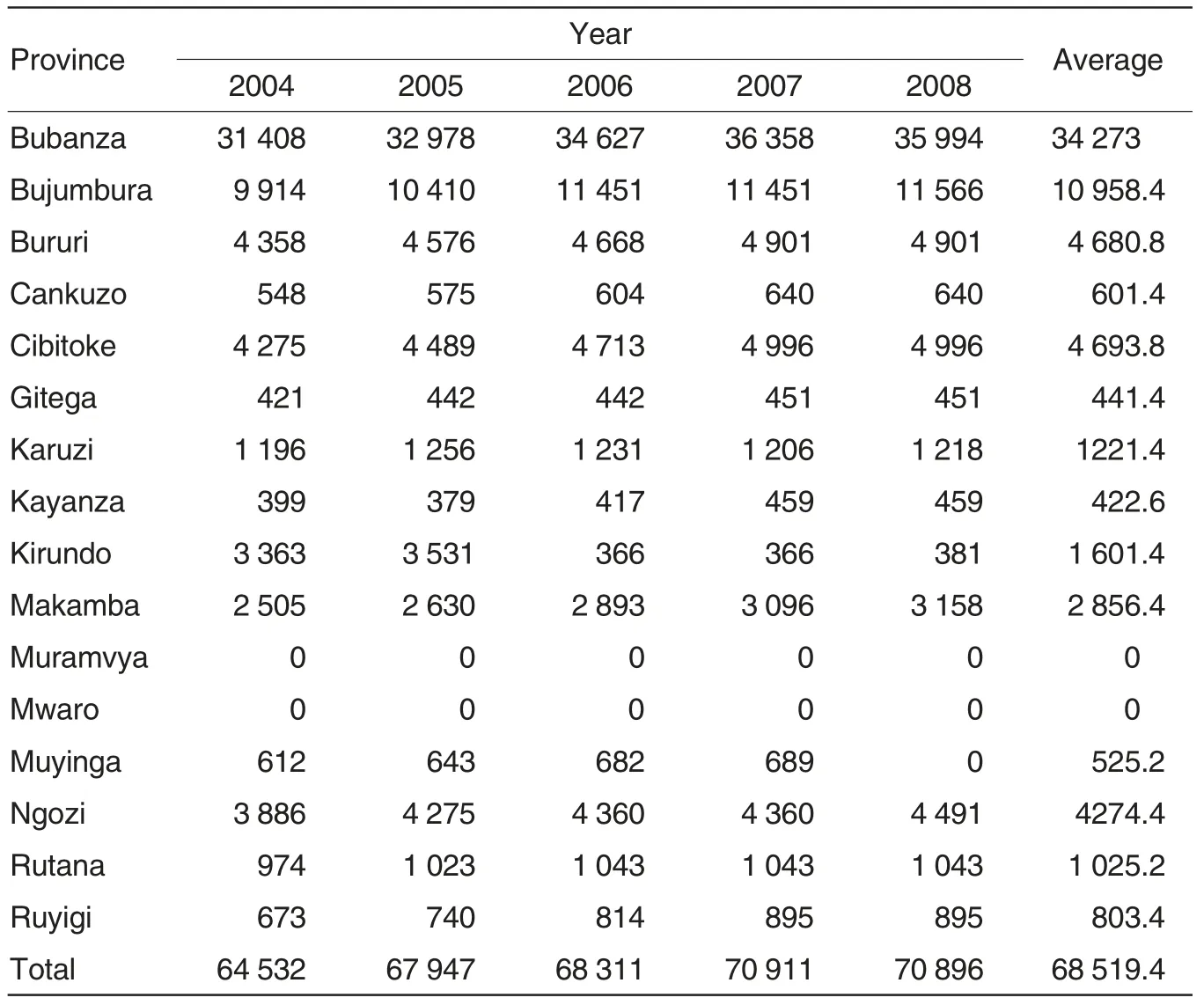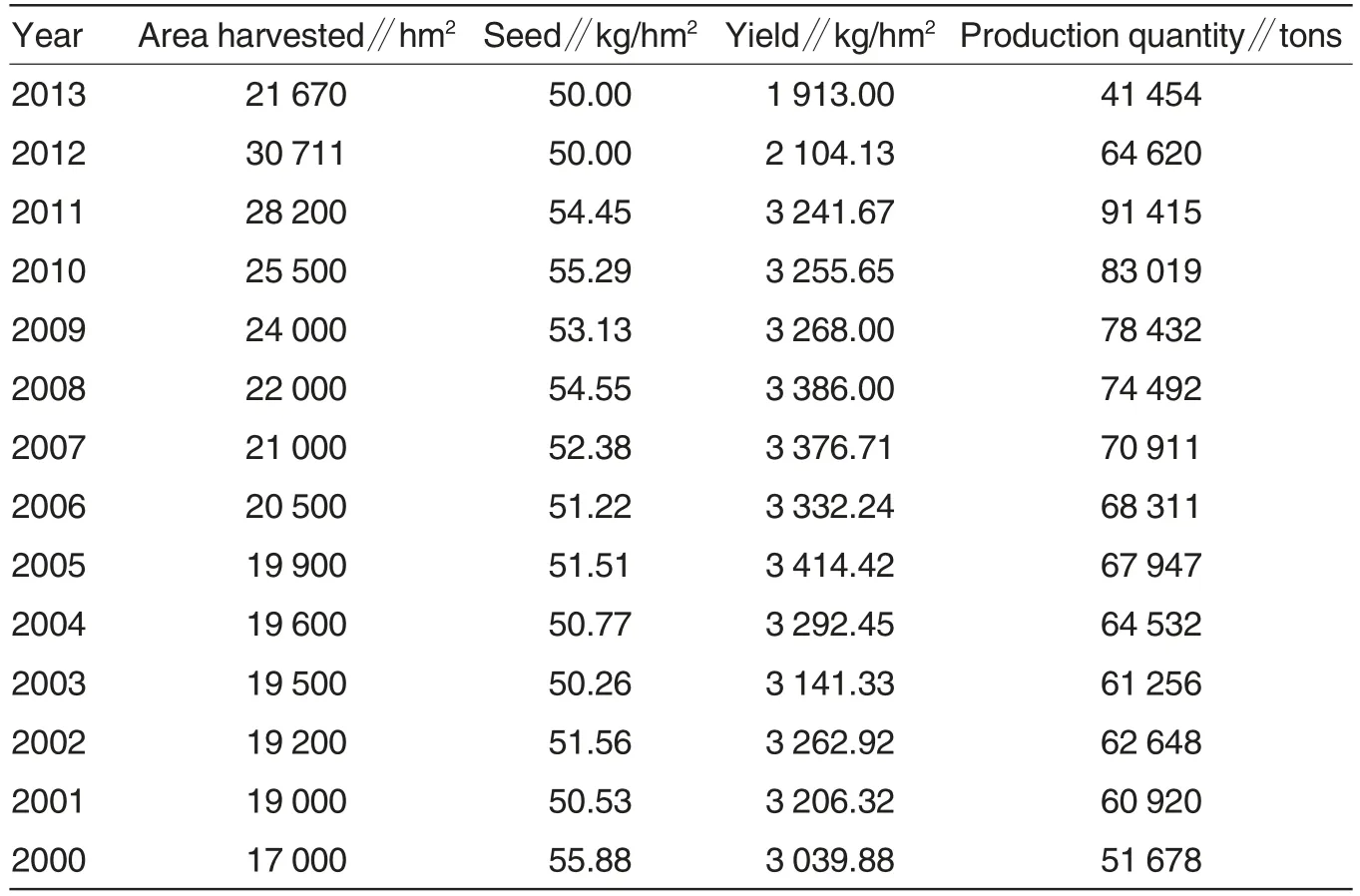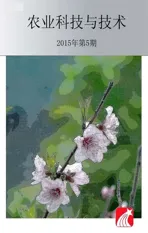Current Status of Rice Production in Burundi and Its Development Strategies
2015-12-13KaiqiangLIUNDIKUMANAMathieuYuWEIXiaoqiongLISibinGUOYuyiHUANGDajinSHIJuzhiLUFeiyanYANCaihongCHENGuoqingGAO
Kaiqiang LIU, NDIKUMANA Mathieu, Yu WEI, Xiaoqiong LI, Sibin GUO, Yuyi HUANG, Dajin SHI, Juzhi LU, Feiyan YAN, Caihong CHEN, Guoqing GAO*
1. Guangxi Academy of Agricultural Sciences, Nanning 530007, China;
2. Institute of Sciences Agriculture of Burundi, Bujumbura 999107, Burundi;
3. Rice Research Institute, Guangxi Academy of Agricultural Sciences, Nanning 530007, China;
4. Agriculturual Resources and Environment Research Institute, Guangxi Academy of Agricultural Sciences, Nanning 530007, China;
5. Maize Research Institute, Guangxi Academy of Agricultural Sciences, Nanning 530007, China
Burundi, officially named the Republic of Burundi, is a landlocked country locked in the east of Africa, bordered by Rwanda to the north, Tanzania to the east and south,and Democratic Republic of the Congo to the west. It’s one of the five poorest countries in the world with the lowest Gross Domestic Product(GDP)and per capita GDP of any nation[1].The GDP at current prices is 25.5 billion US dollars and per capital GDP is 251 US dollars with the growth rate of 4.6% in 2013[2]. Generally, about 50%financial revenue in Burundi needs aid from the other countries or organizations[3]. The economy is predominantly agricultural with more than 90% of the population dependent on subsistence agriculture[4].
Food security in Burundi is still only an aspiration. According to the Global Hunger Index of 2013, Burundi has an indicator ratio of 38.8, earning the nation the distinction of being the hungriest country in the world in terms of percentage[5].Approximately 80%of Burundi’s population lives in poverty[6].With an equatorial climate full of arability for crops, Burundi’s lands are mostly agricultural or pasture. But it’s a pity that settlement by rural populations has led to deforestation,soil erosion and habitat loss[7].
Rice is one of the major and luxurious consumed foods in Burundi. In order to improve the production of rice and keep the food safe,the strategy of Burundi government is primordially to increase all of agricultural sector budgets through Agricultural Ministry by developing practical technology and tolerant varieties to diseases, insects,pests and the crucial problem of salinity especially in low land[8]. Deforestation of the entire country is almost completely due to overpopulation. Under the stress of 10.48 million population[9]and the limited agricultural land area of 1.88 million hm2, the government also plan to develop the middle and high altitude land including the swamps unexploited by introducing short growth duration varieties such as some vegetables,pasture and fruits.
However, when a thing is rare, it becomes precious. Less rice makes expensive. A lot of consumers are actually limited by increasing of rice prices at market. Agricultural field operations consume about more than 70% of expenses in term of money in field work since 2009[10]. This rapid inflation is mainly caused by increasing of mineral fertilizers and labor costs .Because when the price of all products including service go up in the Market ,the agricultural cost must also increase together with inputs of goods and materials, especially the increasing labor salaries.
Rice is one of the main and traditional crops in Burundi.It’s usually believed that the rice culture has been introduced by Arabian near the Lake Tanganyika around Bujumbura. It’s called upland rice. The yields were very low because of the utilization of several original varieties (unscreened seeds)and lack of technology.
SupportedbyEU(EuropeanUnion)in 1969,the irrigated channel has been managed at Imbo plain in north of the capital Bujumbura. Then the rice culture makes a considerable expansion whose the importance is going to increase nowadays. Today, the rice is almost produced in every provinces and the current national production has remarkably increased. This achievement is not resulted of rice importance but rather the efforts of whole Burundi. This paper mainly showed the rice production, and major constraints in Burundi and discussed the developing strategies.
Ecological Types of Rice in Burundi
The rice culture in Burundi has three ecological systems followed: the low land rice, the middle land rice and the upland rice[10-13].
The low land rice
The low land rice mainly distributed in alluvial Imbo plain between the altitude of 1 100 and 1 300 m. This area go roughly along the national road RN5 and RN9 including the national rice main producing areas of Bujumbura, Maregete, Mpanda,Bubanza and Buganda. The irrigated rice constitute this ecology type which is completely adapted to plant rice.The soil in this area is sandy clay and expediently for irrigation. And the yields are very high because of the good controlling of cultural techniques and the exploitation of good varieties.
The middle land rice
This type of riziculture which begun in 1981 according to research mainly distributed between the altitude of 1 400 m and 1 700 m. Even recently, it’s known more and more as an extension of rice planting in middle land.The rice in this area benefits only the favorable water feeding from the ground water and some flooding of rivers.The practice of fallow in order to restore the fertility of swamps which don’t benefit the opening of mineral or organic fertilizer. And the excessive hydromorphy observed in these swamps during rain season and which aren’t adapted to other crops without rice and pasture. The introduction of rice in Swamps in middle land has been understood by the government and ISABU after they have noticed than Burundi possess a high agricultural potential constituted by big area about 112 000 hm2.

Table 1 Diffused varieties and yields
The upland rice
This type of rice is practiced in the flooding conditions without irrigation near the la lake Tanganyika on the Mumirwa region and Moso region.It’s possible to grow rice there until 1300 meters of altitude. In these conditions,the rice water feeding exclusively depends on rainfall. The water retention capacity is expecially important for yield.
Major Constraints of Riziculture in Burundi
The low night temperature
In middle land and the place between 1 400 and 1 700 meters of altitude, the low temperature provokesthe long growth duration of rice and an augmenting of sterility of spike during harvest. This sterility result of perturbations by variation of weather conditions are caused by cool in the time of reproductive phase of floral organs during differentiation and anthesis period.It is thus very important to make many crossings among different varieties in order to increase the chance for getting the genotypes with many tolerant genes.Regarding this weather constraint, the rice area in the middle land can occupy around 99 500 hectares.

Table 2 Production of paddy rice per Province tons/year
The bacterial disease
It’s the main kind of disease commonly called Foliar Gain Rot in Burundi. For firstly, it was discovered in 1982 after diffusion of the variety Yunnan-3. It is currently observed where the rice is grown to more than 1300 meters of altitude .The characteristic symptoms are the brown color,total or partial locking of foliar gain panicle which isn’t emerged. It’s the critical stage from elongation to flowering time with high relative humidity and low temperature under 20 ℃during the day. It’s has been identified as favorable factor for developing the foliar gain rot. So, this disease is very serious to cultivated varieties improved by artificial breeding which have the short straw.
The blast disease
This fungal disease is the one of major crucial problems for almost rice earlier in Burundi. In cultural seasons from 1987 to 2001 showing as Τable 1, the blast disease has completely destroyed some local and introduced rice varieties.
Rice Production in Main Province
There are 16 provinces in Burundi including the capital Bujumbura. From the year 2004 to 2008, the riziculture mainly distributes in province Bubanza,Bujumbura, Bururi, Cibitoke and Ngozi. The percentage of the whole paddy rice production in 5 provinces above is around 86%.The productions of paddy rice in province Karuzi,Kirundo, Makamba and Rutana range from about 1 000 to 3 000 t per year and range from 500 to 900 t in province Cankuzo, Gitega, Kayanza,Muyinga and Ruyigi. There is almost no rice in province Muramvya and Mwaro. So the riziculture is practiced in Imbo plain, Moso and middle land where the cultivation conditions are especially suitable for irrigating rice.

Table 3 Production of paddy rice in Burundi by year
Rice Production in Burundi
The production of rice changed a lot in history. The area harvested(AH) of rice was no more than 2 000 hm2/year and the production quantity(PQ) was less than 3 000 tons/year before the year 1968. It’s a extremely difficult period in Burundi history for there were no enough rice for eating.From the year 1968 to 1983, it’s a steady development period for the AH increased from about 2 000 hm2/year to 5 000 hm2/year and PQ increased from about 3 400 tons/year to about 10 000 tons/year. There was a rapid development period between the year 1984 to 1989. The AH increased quickly from 3 500 hm2/year in 1983 to 12 000 hm2/year in 1989 and the PQincreased from 9000 tons/year in 1983 to 40 000 tons/year in 1989.It kept the good status quo for about ten years from 1989 to 1998. In the past 15 years, the PQ broke 50 000 tons in 1999 and it went in another steady development period until the year 2011. The yield got a sharp drop in 2012 and 2013 because of the natural disasters and the decrease in area[10].So the PQ dropped deeply from 91 415 tons in 2011 to 41 454 tons in 2013.
The average yields keep steady in recent 10 years except 2012 and 2013. Usually the yields reach 5 000 kg/hm2for low land, 3 000 kg/hm2for middle land and under 1 000 kg/hm2for upland rice.
Conclusion
Agriculture is crucial for stable development and poverty reduction efforts in Africa.It is a pillar industry and a priority field for development in Burundi[14].Rice is one of the most important crops in Burundi but in short supply. The production quantity of paddy rice is 41 454 tons and the population is 10.48 million (FAO, 2014) in 2013.So the average occupancy of lock paddy rice for Burundi people is only 3.95 kg/year in 2013. The producer price of rice in Burundi goes up year by year especially from 2004 to 2006(Fig.1). It’s a severe situation for Burundi government and a magnificent dream for Burundi people to produce more and more rice.
The major constraints for rice production in Burundi are namely the seed quality,unimproved varieties,the lack of technology and factories for producing mineral fertilizers and chemical pesticides,even the un existence of agricultural mechanization services and un sufficiency of irrigation water. The lack of incentive policy, local agricultural banks or agricultural organizations are also the important reasons in the long run. So the suggested strategies for rice production are as follows.
First, give and support agriculture the priority for development at any time. Agriculture is the main and pillar industry in Burundi. Burundi government made an emphasis on the priority to the development of agriculture in the agreement with IMF in 1991 and the Africa State Community Contact Conference in 2011. The government need a long agricultural development planning,and should increase financial investment in agriculture year by year.Also the incentive policy for agriculture is very important for primary development.
Second, establish extension service system of rice production. On the base of companies such as Imbo Development Company(IDC)majoring in agriculture, get much more aid from UN,EU and other organizations to improve agricultural production conditions. It’s better to create the service organizations at the grass-roots level so that farmers can be facilitated to get good rice seeds, any kind of fertilizers and various machine services so that the farmers can use some modern equipment to increase the yield and decrease the labor cost.
Last, open up and cooperate with the outside for technology. In order to overcome the lack of new varieties and technologies, integrate research resources including universities and institutes for the same research object.As one of the top research institutes in Burundi, the ISABU needs more cooperation with international institutes for exchanging materials especially the hybrid rice,jointing training of technical personnel.
Referenes
[1]WIKIPEDIA.Burundi[EB/OL].[2015-01-27].http://en.wikipedia.org/wiki/Burundi
[2]National Accounts Main Aggregates Database(NAMAD) [DB/OL]. [2014-12-31]. http://unstats.un.org/unsd/snaama/Introduction.asp
[3]LUAN. Burundi's national assembly passes 2013 budget bill[EB/OL].[2012-12-28]. http://news.xinhuanet.com/eng-lish/world/2012-12/28/c_132067754.htm
[4]CIA World Factbook. Burundi [EB/OL].[2005-11-01]: http://www.answers.com/topic/burundi
[5]WELTHUNGERHILFE, IFPRI, and concern worldwide. 2013 global hunger index-the challenge of hunger: building resilience to achieve food and nutrition security[R]. Bonn, Washington D. C.,Dublin,2013.
[6]Institute for Security Studies. Burundi population, 2008 [R]. Wayback Machine,2008.
[7]BERMINGHAM, ELDREDGE, DICK,CHRISTOPHER W. and MORITZ,CRAIG. Tropical Rainforests: Past,Present, and Future [M]. Chicago, Illinois:University of Chicago Press,2005.
[8]Ministry of Agricultural of Burundi.Yearbook of Burundi agriculture[R].Bujumbura:2014.
[9]FAOSTAT. Burundi [DB/OL]. [2015].http://faostat3.fao.org/browse/area/29/E
[10]Institute of Agricultural Sciences of Burundi. Annual report of ISABU[R].Bujumbura:2000,2010.
[11]Ministry of Agricultural of Congo. Regional seminar report, crop and improvement of rice and corn of community economic countries [R]. Bukavu,RDC:1989.
[12]Institute of Agricultural Sciences of Burundi. Second day of agronomic research in Burundi[R]Bujumbura,1997.
[13]Institute of Agricultural Sciences of Burundi. Training workshop of techniques on the production and preserving of rice seeds[R].Bujumbura:2002.
[14]Ministry of Commerce People's Republic of China. China -Africa economic and trade cooperation[EB/OL].[2013].http://vienna2.mofcom.gov.cn/article/chinanews/201309/2013090028 0106.shtml
杂志排行
Agricultural Science & Technology的其它文章
- Effect of Meteorological Factors on Yield of Cotton in Different Years
- Breeding of Mycoplasmal pneumonia-negative Swine Population Using Combination Therapy,Segregated Early Weaning(SEW)and Three-point Production System
- Land Use Situation and Strategies under the Background of New Urbanization in Yunnan Province
- Analysis of Heavy Rainstorm in Dongting Lake on July 4,2014
- Regeneration Cultivation Technology of Flammulina velutipes in Factories
- Study on FTIR Spectra of Corn Germs and Endosperms of Three Different Colors Combining with Cluster Analysis
